Av Andreas Graven, Uni Research
The method will be tested in the world’s first ‘real world’ simulation of a deep water emission from a subsea carbon storage reservoir.
The simulation is to take place in order to increase the safety of offshore carbon capture and storage (CCS). CO₂ will be injected into mud at the bottom of the North Sea, 100 km North East of Aberdeen.
This site is a depleted gas field and is one location proposed for CCS development. This is a “hot topic” for researchers these days and one of the challenges is the concern about possible effects on the marine environment if CO₂ were to migrate from primary storage reservoirs during or after the operation.
- For several years researchers at Uni Research have worked to develop a method for monitoring CO₂ emissions in seawater, which is of big importance when it comes to large scale storage. We have increased our competence in the field considerably, and might already have a possible contribution to the solution of the monitoring challenge, says Abdirahman Omar, a researcher and chemical oceanographer at Uni Research in Bergen, Norway.
If CCS becomes a reality porous sandstone rocks under the North Sea could be used for permanently storing large volumes of carbon dioxide, which will decrease the CO₂ emitted to the atmosphere.
The new method has already shown great promise in a recent “concept of proof” study. Omar is therefore excited about the forthcoming North Sea experiment in 2018.
Project leader, Dr Doug Connelly from the NOC, said “Currently, it is challenging to detect and quantify CO₂ emissions in the marine environment because of dispersion and attenuation effects, the small volumes involved and considering large existing natural variability. This project is a really exciting opportunity to develop innovative, safe and cost effective technology to address these problems.”
Omar and his colleague, Truls Johannessen, are part of the big project called STEMM-CCS (STrategies for the Environmental Monitoring of Marine CCS), which has received funding from the European Union’s Horizon2020 project.
In addition to the industry partner Shell, this project will also bring together the universities of Southampton and Heriot Watt, Plymouth Marine Laboratory, GEOMAR and MPI from Germany, NIVA, Uni Research and the Universities of Bergen and Tromsø from Norway.
Several research institutions with different type of methods will measure from different installation types. Omar explains how the Uni Research method can detect CO₂ emissions.
- Sea water contains a certain amount of carbon to begin with, but the concentration varies with time and space. So, if you check a possible emission in a specific place, the signal from the emission might be weaker than the natural variability, Omar says.
To overcome this obstacle, the researchers at Uni Research have managed to develop a technique that filters out the natural changes.
- By studying an area over some time, we can map variations and correct for them. In practice this means that natural variability of CO2 are shown in smaller, more stable curves. As the noise decreases, the signal we are looking for - the emission - becomes easier to detect, Omar says.
An important premise for the method is to understand these natural variations. Furthermore, we need to map variations in advance, Omar adds.
In order to ‘listen’ for emissions the project partners will be developing acoustic and chemical sensors that can be fitted into robot-subs. Automated photographic analysis software will also be developed to enable the detection of any visual changes at the release site.
Additional technology used by this project will include devices in the water and on the seabed to monitor changes in the chemistry, temperature, salinity and currents in the water.
All this technology will be launched into the site in Scotland a year before.

